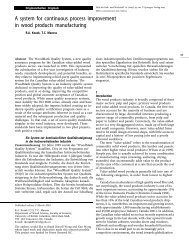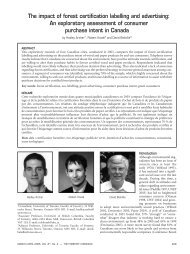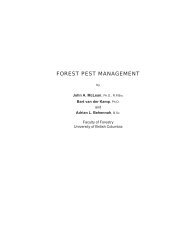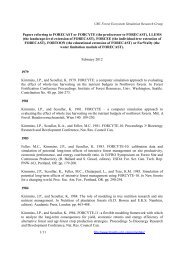Particleboard performance requirements of secondary wood ...
Particleboard performance requirements of secondary wood ...
Particleboard performance requirements of secondary wood ...
You also want an ePaper? Increase the reach of your titles
YUMPU automatically turns print PDFs into web optimized ePapers that Google loves.
Figure 1. — Comparison <strong>of</strong> PB properties with MDF and ply<strong>wood</strong>.The most significant advantages, in rank, were finishing characteristics(0.82), sanding required after machining (0.48),warpage (0.40), machining speed (0.34), uniform thickness(0.33), acoustics (0.32), and machining problems (0.28). Ofthe remaining 4 characteristics, respondents overwhelminglyindicated that PB was superior to MDF in terms <strong>of</strong> lowerweight and lower cost. These PB advantages were among thehighest weighted characteristics at −0.75 and −0.45, respectively.These levels were comparable to MDF’s top-rated advantagesin finishing characteristics (0.82) and in sanding requiredafter machining (0.48).The comparison <strong>of</strong> PB with ply<strong>wood</strong> was more divided. PBand ply<strong>wood</strong> were each identified as being better than theother in some <strong>of</strong> the 10 characteristics. Ply<strong>wood</strong> is perceivedas being overwhelmingly better than PB in fastening strength(0.68), moisture resistance (0.58), resistance to sagging(0.58), and fastening problems (0.42). PB was selected asoverwhelmingly better in terms <strong>of</strong> cost (−0.65), warpage(−0.50), and uniform thickness (−0.48).Evaluation <strong>of</strong> PB <strong>performance</strong>Secondary <strong>wood</strong> producers were also asked to rate the importance<strong>of</strong> PB characteristics on their purchasing decisions.These characteristics were examined in seven general areas:fastening properties, glue/adhesion properties, machiningcharacteristics, panel stability, physical properties, physicalquality, and cost and customer objections. Importance wasrated on an interval scale from 1 to 5, with 1 representing lowimportance and 5 representing high importance. The averageresponse for each characteristic was above the neutral value <strong>of</strong>3, indicating that respondents generally perceived all characteristicsto be at least somewhat important, as shown in Figure2. The average importance ratings had a limited range from3.4 to 4.2 in all seven areas. Gluing and adhesion propertieswere rated as being <strong>of</strong> the highest importance in purchasingdecisions, while physical properties were rated the lowest.The comparison <strong>of</strong> the seven general areas above provides aconcise means to compare important considerations in thepurchasing <strong>of</strong> PB, but it does notprovide sufficient information onthe area in which to focus PB improvements.Specifically, the classification<strong>of</strong> these general areas tendsto mask the important details thatcontribute to the mean scores. In orderto better understand the specificneeds <strong>of</strong> <strong>secondary</strong> manufacturers,the survey also examined specificproperties <strong>of</strong> PB in each <strong>of</strong> the sevengeneral areas in more detail, asshown in Table 2.Almost every general characteristichad at least one property rankedin the top 10, as well as some lowerrankings. For example, althoughmachining characteristics ranked inthe middle <strong>of</strong> the general groupings,melamine edge chipping during machiningranked second. Only theproperties in the general gluing/adhesion characteristic all rankedhigh, while those in physical propertiesall ranked low. The detailed properties with the highestimportance rankings (4 or higher on the importance scale)were, in order from the highest: edgeband peel/delaminationresistance (4.5), melamine edge chipping during machining(4.5), flatness/warp (4.5), cost (4.4), laminate peel/delamination resistance <strong>of</strong> face (4.3), board surface smoothness(4.3), fasteners loosening over time (4.1), resistance tomoisture and swelling (4.1), resistance to sagging and permanentdeflection under load (4.0), and panel thickness issmaller or larger than specified (4.0). The properties with lowestranked importance were, in order from the lowest: compressionstrength perpendicular to the face (3.0), machiningspeed should be faster (3.1), tensile strength parallel to theface (3.2), PB panel width and length are smaller or largerthan specification (3.2), edge sanding is required after machining(3.3), thermal resistance (beside heat source/stove)(3.3); heavy weight/mass (3.3), tensile strength perpendicularto the face (3.3), and nail/staple withdraw resistance fromboard edge (3.4).A comparison <strong>of</strong> the average property importance ratingsagainst commonly encountered quality problems also revealsseveral interesting findings. Table 2 shows the ranking <strong>of</strong>property importance against how <strong>of</strong>ten respondents reportedencountering problems with each respective property. One interestingtrend is that there appears to be little correlation betweenthese two criteria. For example, the largest proportion<strong>of</strong> producers, 74 percent, reported problems with melamineedge chipping during machining, but this property was rankedonly the second highest problem in importance. The secondlargest proportion, 59 percent, reported problems with impuritiesbut ranked this property 12th in importance. Likewise,57 percent <strong>of</strong> producers encountered problems with panelwarp, but ranked this 11th in importance, and 56 percent <strong>of</strong>respondents encountered problems with customer objectionsbut ranked this 19th.The issue <strong>of</strong> quality-control problems and property importancewas further examined by comparing how the companiesFOREST PRODUCTS JOURNAL VOL. 58, NO. 3 37
Figure 2. — Mean importance <strong>of</strong> PB characteristics – overallby general categories.responded to the questions concerning the testing <strong>of</strong> PB properties.Fully 34 percent <strong>of</strong> respondents who identified the importance<strong>of</strong> various properties as high (an importance rating <strong>of</strong>4 or 5) indicated that that they never test for them, while 33percent and 18 percent responded sometimes and <strong>of</strong>ten, respectively(Fig. 3). Only 15 percent indicated that they alwaystest for the high importance PB properties. Even more curiouswere the replies <strong>of</strong> respondents who reported problems withparticular PB properties. A total <strong>of</strong> 62 percent responded thatthey never or only sometimes test for the property that theyencountered problems with, as shown in Figure 4. Only 17percent <strong>of</strong> respondents reported always testing for theseproperties.PB improvement prioritiesAfter answering detailed questions regarding the importance<strong>of</strong>, problems encountered with, and the testing <strong>of</strong> PBproperties, manufacturers were asked to identify and prioritizethe PB characteristics that they would like to see improved.In this section, the seven previous general characteristics(see Fig. 2) were expanded to nine by separating costand customer objections/<strong>requirements</strong> and by adding sanding.3 In this question, a value <strong>of</strong> 1 indicated a low priority forimprovement, a value <strong>of</strong> 9 indicated a high priority, and 5represented a neutral value between these two extremes. Producerswere asked to rate each <strong>of</strong> the nine potential areas forimprovement on this 9-point interval scale.Means for each improvement area were computed and areseen in Figure 5. On average, while the priorities identified byproducers are not conclusive, some interesting trends arenoted when the order that categories were ranked in are comparedto the rankings <strong>of</strong> the importance <strong>of</strong> general characteristicsshown in Figure 2. The highest average priorities forimprovement were for fastening properties (6.5), cost (6.3),machining (6.1), and panel stability (6.1). The lowest prioritieswere given to customer <strong>requirements</strong> (3.8) and sanding(4.0). This is in contrast to the ranking <strong>of</strong> various importantcharacteristics to purchasing decisions. In purchasing decisions,fastening was ranked low in importance, while glue/3 Cost was added because it is typically a key characteristic controlling the PBpurchasing decision. Sanding and customer objections/<strong>requirements</strong> were addedbecause they were previously noted as factors for selecting MDF over PB (Suchslandand Good 1968).adhesion was ranked high. It is also clear from the improvementrankings that cost has a considerably higher priority to<strong>secondary</strong> manufacturers than do customer <strong>requirements</strong>.Segmentation by industry sector, annual sales,and process typeIn addition to questions related to PB <strong>performance</strong>, respondentswere also asked to indicate the annual sales, processtype, and industry sector <strong>of</strong> their manufacturing businesses.These characteristics were used for segmentation purposes toexamine differences in response patterns and, ultimately, toprovide information to direct target marketing and product developmentefforts.When the detailed property importance rankings were segmentedby the annual sales <strong>of</strong> the manufacturers, some interestingdifferences became apparent. Respondents from companieswith annuals sales <strong>of</strong> $1 million or less tended to rankall properties as more important than companies with higherannual sales. The fastening properties <strong>of</strong> PB were much moreimportant to companies with lower sales. The highest rankedfastener properties were fasteners loosening over time (4.7),screw withdraw resistance <strong>of</strong> face (4.5), screw withdraw resistance<strong>of</strong> edge (4.5), nail/staple pull-through resistance <strong>of</strong>face (4.3), nail/staple withdraw resistance from edge (4.3) andnail/staple withdraw resistance from face (4.2). Producerswith annual sales <strong>of</strong> over $5 million ranked PB panel thicknessvariation (4.4) and length and width variation (3.8) asbeing more important to them than companies having annualsales <strong>of</strong> $5 million or less. Companies with annual sales from$1 million to $5 million ranked PB properties generally in linewith the companies in either or both <strong>of</strong> the other two incomecategories.When the improvement priorities were segmented by annualsales, several other differences also became evident. Producershaving annual sales <strong>of</strong> greater than $5 million ratedglue/adhesion properties (6.6) and physical quality (5.5) asthe highest priorities for improvement. These were significantlyhigher than companies with lower sales levels. Producerswith annual sales <strong>of</strong> $1 million or less rated cost (6.8) andfastening (6.7) as the highest priorities for improvement. Machiningwas rated the highest priority (6.5) for companies withbetween $1 million and $5 million annual sales.Segmentation <strong>of</strong> the property importance rankings by productsmanufactured or types <strong>of</strong> processing employed did notreveal many notable differences. Furniture and cabinet manufactureshad similar response patterns with respect to the importance<strong>of</strong> various panelboard properties. That said, othertypes <strong>of</strong> companies (mainly engineered <strong>wood</strong> products producers)tended to have differing responses. These companiesindicated that overall fastening and machining propertieswere not as important, while overall panel stability and qualityproperties were very important. An evaluation <strong>of</strong> responses byprocess type (batch, continuous, and batch plus continuous)also did not reveal many notable differences with respect tothe importance <strong>of</strong> panelboard properties.However, when the improvement priorities were segmentedby process type, differences between batch and continuousprocess line producers were revealed, with respondentsusing continuous processes generally ranking improvementproperties higher. The highest ranked properties forimprovement were cost (7.3), glue/adhesion properties(6.8) and fastening (6.8). The largest disagreement between38 MARCH 2008
Table 2. — PB property importance compared to percentage encountering problems.Relative ranking (1 to 36) <strong>of</strong> each PB characteristic is noted in parentheses.PB characteristicImportance priority1-low, 5-high(ranking)Percentageencounteringproblems (ranking)Gluing/adhesion propertiesEdgeband peel/delamination resistance - brd edge 4.5 (1) 48% (8)Laminate peel/delamination resistance - brd face 4.3 (5) 38% (17)Panel is difficult to glue 3.8 (16) 23% (27)Cost and customer objectionsCost 4.4 (4) 38% (16)Customer objections to <strong>Particleboard</strong> use 3.7 (19) 56% (4)Physical qualityFlatness/warp 4.5 (3) 48% (9)Board surface smoothness 4.3 (6) 27% (20)Impurities in the panel 4.0 (12) 59% (2)Hardness 3.7 (22) 19% (30)Abrasion resistance 3.5 (26) 23% (26)Machining characteristicsMelamine edge chipping during machining 4.5 (2) 74% (1)Panel warpage after machining 4.0 (11) 57% (3)Other laminate edge chipping during machining 4.0 (13) 52% (7)Tool life is short (tool wear is high) 3.8 (15) 53% (5)PB panel chipping during machining 3.7 (21) 53% (6)Edge sanding is required after machining 3.3 (32) 40% (14)Machining speed should be faster 3.1 (35) 24% (25)Panel stabilityResistance to moisture and moisture swelling 4.1 (8) 46% (10)Sagging resistance or permanent deflection under load 4.0 (9) 40% (15)PB panel thickness is smaller or larger than specified 4.0 (10) 25% (22)PB panels are square and have straight edges 3.7 (20) 20% (28)Aging or degradation with time 3.5 (25) 14% (32)PB panel width & length are smaller or larger than spec. 3.2 (33) 15% (31)Fastening propertiesFasteners loosen over time 4.1 (7) 44% (12)Screw withdraw resistance <strong>of</strong> board face 3.9 (14) 33% (18)Screw withdraw resistance <strong>of</strong> board edge 3.8 (17) 45% (11)Nail/staple withdraw resistance from board face 3.6 (24) 33% (19)Nail/staple pull-through resistance <strong>of</strong> board face 3.5 (27) 25% (23)Nail/staple withdraw resistance board edge 3.4 (28) 44% (13)Physical propertiesMoisture content 3.8 (18) 19% (29)Bending stiffness and strength 3.7 (23) 27% (21)Tensile strength perpendicular to the face 3.3 (29) 9% (34)Heavy weight/mass 3.3 (30) 24% (24)Thermal resistance (beside heat source/stove) 3.3 (31) 12% (33)Tensile strength parallel to the face 3.2 (34) 6% (36)Compression strength perpendicular to the face 3.0 (36) 8% (35)producers with batch and continuous processes was in the category<strong>of</strong> customer <strong>requirements</strong>. Producers using continuousprocesses ranked this higher (5.6) than producers using batchprocesses (3.9).DiscussionThe survey results obtained in this study were expected but,in many instances, were also surprising. First, the results showthat <strong>secondary</strong> <strong>wood</strong> productsmanufacturers in Canada overwhelminglyperceive MDF as beingbetter than particleboard. MDF wasselected as better (0 to 1, on average)than PB in 16 <strong>of</strong> the 20 characteristics.The most significant advantages,in rank, were finishing characteristics,sanding required after machining,warpage, machining speed,uniform thickness, acoustics, andmachining problems. These resultsare not particularly surprising sincethey are commonly cited reasons forusing MDF (Maloney 1993). However,what is surprising is that respondentsfelt that MDF was betterthan PB in warpage and resistance tosagging. These properties are typicallynot included in standard testsand studies indicate that they arehighly dependant on panel propertiesand load conditions (Din<strong>wood</strong>ieet al. 1985, Fernandez-Golfin Secoand Diez 1998). Except for cost, theperceived benefits <strong>of</strong> MDF over PBprovide an explanation for the increasingmarket share <strong>of</strong> MDF andthe movement <strong>of</strong> many manufacturersaway from using PB.The comparison <strong>of</strong> PB with ply<strong>wood</strong>appears to be more balanced.Both PB and ply<strong>wood</strong> were identifiedas being superior (compared toone another) in 10 characteristics. Ply<strong>wood</strong>is perceived as being better thatPB in terms <strong>of</strong> fastening strength,moisture resistance, resistance to sagging,and fastening problems. PB wasperceived as better in terms <strong>of</strong> cost,warpage, and uniform thickness. Thisbalance may explain why ply<strong>wood</strong> isgenerally not perceived as a competitorto PB. Each <strong>of</strong> these panelboardproducts tends to have its own uniqueapplications.The PB characteristics identifiedas important and those prioritizedfor improvement produced resultsthat were both anticipated and unexpected.Most <strong>of</strong> the properties thatare included in the PB standard(ANSI A208.1-1999), for whichthere are quantitative measures, generallyranked lower in importance. These include physicalproperties, fastening properties, and panel stability. The characteristicsthat are not included in the standard tended to rankhigher in importance, including gluing/adhesion properties,cost and customer objections, and machining characteristics.This distinction may be an indication that most PB panelboardscurrently produced meet the standards and, as a result,manufacturers may not be that concerned about consistency inFOREST PRODUCTS JOURNAL VOL. 58, NO. 3 39
Figure 3. — Percentage <strong>of</strong> responding companies testing aPB property that indicated that it was high importance (4 or 5).Figure 4 — Percentage <strong>of</strong> responding companies testing a PBproperty with which they encountered problems.Figure 5. — Mean PB improvement priority (range bars showthe 95 percent confidence interval around the mean).these areas. It may also indicate that characteristics not includedin the standard are subject to higher degrees <strong>of</strong> variation.As such, this may mean that improvements in the perceptions<strong>of</strong> PB <strong>performance</strong> could potentially be accomplishedby expanding the existing standard to include morePB characteristics.It is interesting to note that the PB characteristics ranked byrespondents as important and those prioritized for improvementare <strong>of</strong>ten different. Fastening properties were rankedlow in importance but were prioritized as the highest area forimprovement. Glue/adhesion properties were ranked thehighest in importance but prioritized sixth for improvement.This apparent contradiction may be due to specific problemsand/or preconceptions <strong>of</strong> the causes <strong>of</strong> problems. For example,five the <strong>of</strong> the six fastening properties were ranked lowin importance, but one, fasteners loosening over time, wasranked high (7). Fasteners loosening would generally be perceivedas being caused by the PB itself. On the other hand,gluing and adhesion properties were ranked high in importance,but manufacturers may not consider PB as being themain cause. Most manufacturers will typically make adjustmentsto the tooling, processing speeds, heating rates, andglue settings to improve gluing and adhesion. As a result, specificproblems and perceptions <strong>of</strong> their causes could affect thestated priorities for improvement. This suggests that someeducation in process troubleshooting may be warranted.Key questions that arise from the survey results revolvearound what the focus for the improvement <strong>of</strong> PB <strong>performance</strong>should be and how the perceptions <strong>of</strong> PB relative toMDF can be improved. The survey results suggest several approaches.First, PB characteristics that were both ranked highin importance and were frequent causes <strong>of</strong> quality problemsshould be targeted as high priorities for improvement. Melamineedge chipping during machining was identified as themost frequent cause <strong>of</strong> quality problems and was also rankedsecond highest in importance. Edgeband peel/delaminationresistance was ranked first in importance and also among thetop 10 causes <strong>of</strong> problems. Likewise, flatness/warp wasranked third in importance and was among the top 10 causes<strong>of</strong> problems.A second approach that could be taken to improve the marketposition and properties <strong>of</strong> PB would be to consider theinherent and perceived differences between PB and MDF.The survey results indicate that MDF’s perceived strengthsare its finishing characteristics, sanding required after machining,warpage, machining speed, uniform thickness,acoustics, and machining problems. Of these characteristics,only finishing characteristics and possibly acoustics may beinherently different in MDF and PB. In other words, it may bepossible to improve the <strong>performance</strong> <strong>of</strong> PB in all the othercharacteristics, such as sanding required after machining,warpage, machining speed, and machining problems. Improvingthese characteristics, combined with a lower cost, mayallow PB to regain some <strong>of</strong> its market share.Improving the perception <strong>of</strong> PB can also be extended beyondimproving the panelboard. The survey results indicatedthat two-thirds or more <strong>of</strong> the <strong>secondary</strong> <strong>wood</strong> productsmanufactures surveyed only sometimes or never tested for PBproperties that were important to them or with which they hadencountered problems. This indicates that there is a significantopportunity to control PB quality at the manufacturerlevel through incoming material inspection, quality control,and testing. Many <strong>of</strong> the problems encountered with PB couldbe identified before the panels enter into the manufacturingprocess. This would reduce manufacturing defects and downtimeand would provide time for the replacement <strong>of</strong> defectivepanelboards. As a result, a third approach could be to developstandard test procedures, protocols, and equipment that couldbe used for PB quality control and inspection.Conclusions<strong>Particleboard</strong> is an important and widely used panelboard invalue-added applications, particularly in the cabinetry andfurniture segments. The key advantage <strong>of</strong> PB over other panelboards,such as MDF and ply<strong>wood</strong>, is its low cost. In mostother characteristics, MDF is perceived to be superior to PB.This includes gluing and adhesion properties, physical quality,machining characteristics, panel stability, fastening properties,and physical properties.40 MARCH 2008
Ply<strong>wood</strong> and PB are considered more balanced competitors.Ply<strong>wood</strong> is generally considered better in fastening properties,while PB is considered better in machining characteristics.Their comparison in other characteristics is mixed.All <strong>of</strong> the general characteristics <strong>of</strong> PB, including gluing/adhesion properties, cost and customer objection, physicalquality, machining characteristics, panel stability, fasteningproperties, and physical properties, were ranked by respondingcompanies as being important. The top-ranked specificcharacteristics were edgeband peel/delamination, melamineedge chipping during machining, flatness/warp and cost. Thatsaid, a surprising result <strong>of</strong> this research was that 67 percent <strong>of</strong>companies only sometimes or never tested PB properties thatthey considered to be highly important. Moreover, 62 percent<strong>of</strong> companies only sometimes or never tested a PB propertywith which they had already encountered problems. The highestpriorities for PB property improvement were identified inthe areas <strong>of</strong> fastening, cost, machining, and panel stability.A number <strong>of</strong> differences were noted among the respondents.Companies with annual sales <strong>of</strong> $1 million or lessranked all PB properties as important, while companies withannual sales <strong>of</strong> greater than $5 million tended to be more specific,ranking panel thickness variation and length and widthvariation as highly important.The survey results highlight three opportunities to improvethe market position <strong>of</strong> PB. The first opportunity is through theimprovement <strong>of</strong> PB properties that are both important to and asource <strong>of</strong> problems for manufacturers, such as melamine edgechipping and edge peel/delamination. The second is throughthe improvement <strong>of</strong> PB properties relative to its main competitorMDF in areas where PB has no inherent disadvantages,such as sanding required after machining and machiningspeed. The third opportunity involves the development <strong>of</strong>standard quality-control tests for PB to allow manufacturersto inspect incoming panels and, thereby, reduce manufacturingproblems.Literature citedDillman, D.A. 2000. Mail and Internet Surveys. The Tailored DesignMethod. John Wiley and Sons, New York. 464 pp.Maloney, T. 1993. Modern <strong>Particleboard</strong> and Dry-Process FiberboardManufacturing. Miller Freeman Inc., San Francisco. 681 pp.Din<strong>wood</strong>ie, J.M., B.H. Paxton, C.B. Pierce, and E.J. Aloysius. 1985.Quantification and prediction <strong>of</strong> creep in particleboard and other <strong>wood</strong>basedsheet materials. In: Proc. <strong>of</strong> the Symp. Forest Production Res.Inter., Pretoria.Fernandez-Golfin Seco, J.I. and M.R. Diez. 1998. Long-term deformation<strong>of</strong> MDF panels under alternating humidity conditions. Wood Sci.and Tech., Berlin. vol. 32, pp. 33-41.Forintek Canada Corporation. 1998. Wood-Based Panel Products Tech.Road Map. ISSN 0381-7733, Industry Canada, Ottawa, Ontario.National <strong>Particleboard</strong> Assoc. (NPA). 1996. <strong>Particleboard</strong> from Start toFinish. NPA, Gaithersburg, Maryland. 136 pp.Resource Information Systems Inc. (RISI). 1999. RISI North AmericanPanelboard Mill Capacity. July. RISI, Bedford, Massachusetts.. (RISI). 2002a. RISI North American Wood Panels AnnualHistorical Data. July. RISI, Bedford, Massachusetts.. (RISI). 2002b. RISI North American Wood Panels Forecast– October 2002. November. RISI, Bedford, Massachusetts.. (RISI). 2003. RISI North American Wood Panels Forecast– January 2003. March. RISI, Bedford, Massachusetts.Rehnert, K. 2000. Particle Performance Requirements for Use in CanadianValue-Added Wood Products. Rept. No. 2000-11-229, ForintekCanada Corp, Vancouver, British Columbia. 99 pp.Suchsland, O. and W.S. Good. 1968. The selection <strong>of</strong> panel materials byfurniture and cabinet manufacturers. Michigan Agri. ExperimentalSta., J. Article No. 4378, Michigan State Univ., East Lansing, Michigan.11 pp.Wu, Q. and R.P. Vlosky. 2000. Panel products: A perspective from furnitureand cabinet manufacturers in the southern United States. ForestProd. J. 50(9):45-50.FOREST PRODUCTS JOURNAL VOL. 58, NO. 3 41








![Forestry in Indian Country: Progress & Promise 9[19] - Faculty of ...](https://img.yumpu.com/31648150/1/190x245/forestry-in-indian-country-progress-promise-919-faculty-of-.jpg?quality=85)
